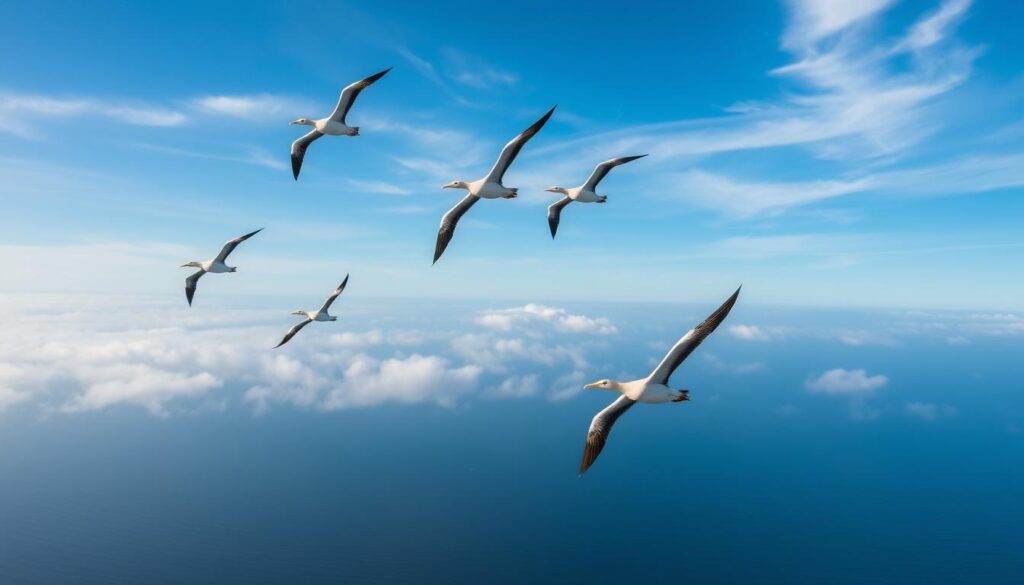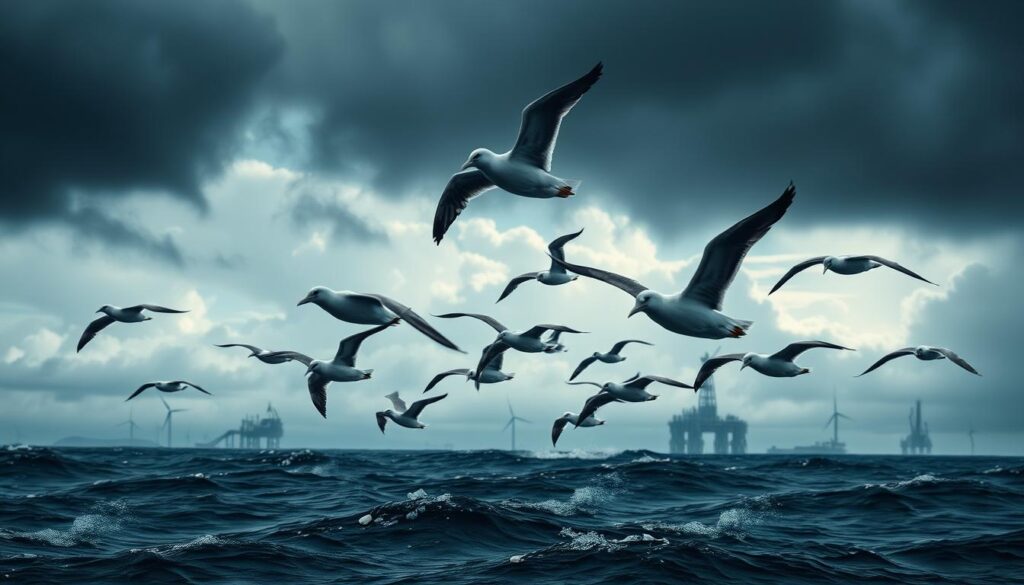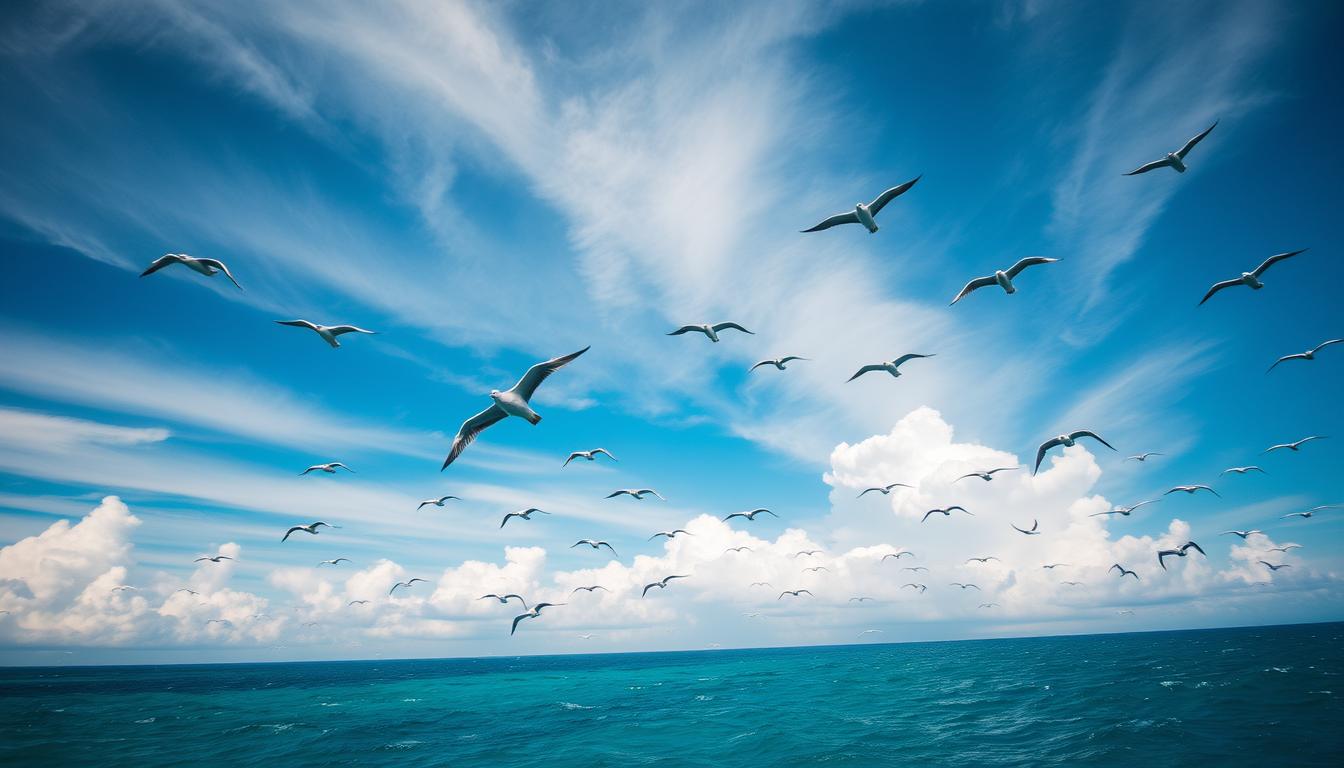Albatross migration is a fascinating phenomenon that has captivated many. These birds, known for their large wings and endurance, travel long distances. Their migration patterns are crucial for conservation and give us insights into their lives.
Albatrosses have adapted to their environment in amazing ways. Their behavior allows them to thrive in different ecosystems. Studying their migration helps us understand bird migration patterns and how the environment affects them.
Researching albatross migration is vital. It shows us how these birds interact with their habitats. This knowledge helps us develop conservation strategies to protect them and their habitats.
Key Takeaways
- Albatross migration is a complex phenomenon that involves impressive journeys across the globe.
- Understanding albatross behavior is crucial for conservation efforts and provides valuable insights into the life cycle of these birds.
- Albatross migration patterns are influenced by environmental factors, such as wind and ocean currents.
- Researching albatross migration informs conservation strategies that protect albatross populations and preserve their natural habitats.
- Albatross migration is an important aspect of their overall behavior and life cycle.
- Conservation efforts are necessary to protect albatross populations and preserve their migration patterns.
Understanding the Majestic Albatross
The Albatross is a bird known for its huge wings and amazing migrations. To get to know these birds, we must look at their physical traits and the different species. Their behavior and where they breed are key to their survival.
Albatrosses have wings that can grow up to 12 feet wide. They also have light bones, which helps them stay in the air for a long time. These features, along with their behavior, make them great at flying long distances.
Physical Characteristics for Long-Distance Flight
Albatrosses have special traits that help them fly far. These include:
- Large wingspans, which provide lift and allow them to stay aloft for extended periods
- Lightweight bones, which reduce their overall weight and make flight more efficient
- Aerodynamic feathers, which help to reduce air resistance and improve their flight capabilities
Species Diversity and Distribution
There are many Albatross species, each with its own traits and where they live. Their breeding grounds are often on remote islands. This is where they nest and raise their young safely. Knowing about their species and where they live is important for protecting them.
The Science Behind Albatross Migration
Learning about albatross migration is key for saving these amazing birds. Albatross tracking technology has helped us understand their travels. Scientists use satellite tracking and other tools to study their behavior and habitats.
Several things affect albatross migration:
- Food availability
- Weather conditions
- Breeding and nesting habits
These factors are watched closely with Albatross tracking technology. It gives us important information about their migration.
Thanks to advanced tracking, we know more about albatross migration patterns. This knowledge helps conservationists protect the birds and their homes.
Studying albatross migration is an ongoing effort. Scientists keep improving their knowledge of these birds. With Albatross tracking technology, they can learn more about what drives albatross migration. This helps in saving these incredible creatures.
Essential Navigation Techniques of Migrating Albatrosses
Albatross migration patterns are shaped by wind, ocean currents, and natural compasses. These birds use these elements to navigate their long journeys. The Albatross population trends depend on their ability to find food and navigate.
Some key navigation techniques for albatrosses include:
- Using wind to save energy and travel far
- Following the sun and stars to guide them
- Navigating currents to find food and avoid dangers

Knowing how albatrosses navigate is crucial for conservation. It helps in protecting their migration routes and habitats. By studying their Albatross migration patterns and population trends, we learn more about these amazing birds.
Mapping the Global Albatross Migration Routes
The global Albatross migration routes are truly amazing. Different species travel across the world’s oceans. Their paths are shaped by wind, ocean currents, and food availability.
Albatross habitat destruction is a big threat. It changes their migration paths and affects their numbers.
Efforts are being made to save the Albatross and its homes. These include:
- Creating protected areas and wildlife reserves
- Starting sustainable fishing practices
- Lowering plastic pollution in oceans
To learn more about Albatross conservation, check outthis resource. It talks about tracking their migrations.
Knowing the Albatross migration routes helps us protect them better. By studying these paths and the effects of Albatross habitat destruction, we can help these birds and their homes for the future.
Seasonal Patterns in Albatross Movement
Albatross migration patterns change with the seasons. Breeding and non-breeding seasons are key. These birds adapt to weather and habitat changes. During breeding, they go to their grounds for courtship and raising young.
In the non-breeding season, they spread out for food and habitats. Research links their migration to food availability. Weather, like winds and storms, also shapes their paths.
Breeding Season Migrations
Several factors influence breeding migrations:
- Availability of suitable breeding habitats
- Access to food resources for breeding adults and their young
- Presence of potential mates and breeding partners
Non-breeding Season Patterns
Non-breeding patterns include:
- Dispersal to various locations in search of food and suitable habitats
- Aggregation at specific feeding grounds, such as ocean upwellings and coastal areas
- Migration to areas with favorable weather conditions, such as trade winds and ocean currents
Understanding albatross migration is crucial for their conservation. By studying their patterns, we can protect these birds and their habitats.
Advanced Flight Patterns During Migration
Albatrosses show amazing flight patterns when they migrate. They cover huge distances with little effort. Their skill in gliding and soaring helps them save energy, making them top flyers among birds.
Some key aspects of Albatross flight patterns include:
- Dynamic soaring, which enables them to harness wind energy
- Gliding, which allows them to cover long distances without flapping their wings
- Soaring, which enables them to stay aloft for extended periods
Protecting Albatrosses and their homes is vital. By learning and keeping their flight patterns and migration ways safe, we help Albatross conservation efforts. This ensures these amazing birds can thrive for years to come.

Breeding Ground Selection and Migration
Albatrosses migrate to specific breeding grounds for nesting. The choice of these grounds is vital for their survival. It impacts the Albatross population trends. Food, nesting site quality, and climate are key factors in this selection.
Studies reveal that albatrosses are faithful to their breeding grounds. They return every year. This loyalty helps them form long-term pair bonds and improve their breeding success. Their breeding grounds are often remote islands, safe from predators and humans.
- Remote island locations
- Abundant food sources
- Suitable nesting sites
- Favorable climate conditions
Understanding albatross breeding and migration is crucial for conservation. It helps us identify protected areas. By preserving these grounds and addressing population trends, we can save this magnificent species.
| Breeding Ground | Location | Colony Size |
|---|---|---|
| Midway Atoll | Pacific Ocean | 1,000,000 |
| Laysan Island | Pacific Ocean | 500,000 |
| South Georgia Island | South Atlantic Ocean | 200,000 |
Modern Tracking Technologies in Albatross Research
Albatross tracking technology has changed the way we study these birds. It lets scientists see where they go and how they live. With new tracking systems, we can follow albatrosses over long distances. This helps us understand their Albatross migration routes and where they like to be.
Satellite tracking and GPS are key tools in this research. They give us detailed info on how albatrosses fly, find food, and raise their young. This info is vital for protecting these birds. It helps us know what dangers they face and how to keep them safe.
Key Benefits of Albatross Tracking Technology
- Enhanced understanding of migratory patterns and Albatross migration routes
- Improved conservation efforts through data-driven decision making
- Increased accuracy in monitoring population trends and habitat use
As we learn more, using Albatross tracking technology with other fields is crucial. This includes ecology and climate science. By combining these, scientists can tackle the big challenges facing albatrosses. This way, we can help these amazing birds and their homes stay healthy for a long time.
Environmental Challenges Affecting Migration
The Albatross faces many challenges during its migration. One big issue is habitat destruction. This harms their places to breed and find food. Human actions like deforestation, pollution, and climate change cause this destruction.
Environmental challenges affecting Albatross migration include:
- Climate change, which alters their food supply and breeding patterns
- Pollution, which affects their health and survival rates
- Habitat destruction, which reduces their available breeding and feeding grounds
Addressing the Albatross environmental impact needs a detailed plan. Efforts like protecting their habitats and cutting down pollution can help. These actions are crucial for the survival of these amazing birds.
Conservation Efforts for Migrating Albatrosses
Protecting albatrosses and their homes is key. The goal is to keep these birds and their habitats safe for the future. International agreements help fight human threats to albatross populations.
Some important steps include:
- Creating protected areas and wildlife reserves for albatross homes
- Setting rules to lower bycatch and prevent fishing gear entanglement
- Supporting research and monitoring to learn more about albatrosses
These efforts help keep albatross populations stable and growing. But, we need to keep working to overcome ongoing dangers.
| Conservation Initiative | Goal | Impact on Albatross Population Trends |
|---|---|---|
| Protected Areas | Safeguard albatross habitats | Positive impact on population growth and stability |
| Regulations on Fishing Gear | Reduce bycatch and entanglement | Decrease in albatross mortality rates |
| Research and Monitoring | Improve understanding of albatross behavior and ecology | Informed conservation decisions and effective management of albatross populations |
Impact of Climate Change on Migration Patterns
Climate change is affecting Albatross migration patterns a lot. Rising temperatures and changing ocean conditions are altering their flight routes and habitats. This is a big concern for their populations.
The impact of climate change on Albatross migration is complex. Temperature increases are changing where their food is found, making it harder to find food during their journeys. Also, changing ocean conditions are affecting their breeding and nesting habits, leading to fewer babies.
Some key factors affecting Albatross migration patterns include:
- Sea level rise, which is altering coastal habitats and nesting sites
- Changes in wind patterns, which are impacting their flight routes and energy expenditure
- Shifts in ocean productivity, which are affecting the availability of food sources
Understanding how climate change affects Albatross migration is key to saving them. By studying the Albatross environmental impact and the effects of climate change, we can work to protect these amazing birds.
| Factor | Impact on Albatross Migration |
|---|---|
| Temperature increase | Alters food distribution, making it harder to find sustenance |
| Changing ocean conditions | Impacts breeding and nesting habits, reducing reproductive success |
| Sea level rise | Alters coastal habitats and nesting sites |
Human Interference and Migration Disruption
Human actions are disrupting albatross migration patterns, especially Albatross habitat destruction. Activities like pollution, overfishing, and coastal construction are major issues. These problems make it hard for albatrosses to migrate, leading to a drop in their numbers.
Several factors are causing Albatross migration problems:
- Habitat destruction: Losing places to nest and feed is a big threat.
- Pollution: Oil spills and plastic harm albatrosses and mess up their paths.
- Climate change: It changes where food is, making it tough for albatrosses to find enough to eat.

To lessen human impact on Albatross migration, we need to act. We must protect their homes, cut down on pollution, and tackle climate change. Doing these things can help albatrosses migrate better and ensure their survival.
Population Trends and Migration Success
Studying Albatross population trends is key to understanding their migration’s impact. Research shows that migration patterns greatly affect their numbers. By studying their routes, scientists learn about growth and decline factors.
Some Albatross species are doing well, while others face big threats. Conservation efforts aim to protect their habitats and migration paths. For instance, satellite tracking helps track their routes and find important conservation areas.
Adapting to environmental changes is crucial for Albatross migration success.
| Albatross Species | Population Trend | Migration Survival Rate |
|---|---|---|
| Wandering Albatross | Stable | 80% |
| Black-footed Albatross | Declining | 60% |
| Laysan Albatross | Increasing | 90% |
Understanding Albatross trends and migration success helps conservationists. They can then protect these birds and their homes. Ongoing research and tracking are vital for their survival.
Supporting Organizations and Research Programs
Albatross conservation efforts need the help of many organizations and research programs. These groups are key in protecting albatrosses and their homes. Albatross research programs study how these birds behave, where they go, and how many there are. This helps us know how to best protect them.
Important groups like the International Union for Conservation of Nature (IUCN) and the World Wildlife Fund (WWF) are involved. They work together to save albatrosses. They do things like protect their homes, reduce bycatch, and teach people about these birds.
Research programs, like the Albatross Research Program, also help. They study albatross behavior, where they go, and how many there are. This information is crucial for saving these birds.
Key things these groups do include:
- Studying albatross behavior and migration patterns
- Protecting their homes and reducing bycatch
- Teaching people about the importance of saving albatrosses
By supporting these organizations and research programs, we help protect albatrosses and their homes. This ensures these amazing birds can thrive for years to come.
Securing the Future of Albatross Migration
Exploring the world of albatross migration shows us how important it is to protect these birds. Conservation efforts, backed by international groups and researchers, are key. They help ensure albatrosses can keep migrating successfully around the world.
Climate change, habitat loss, and human actions threaten albatrosses. We must work harder to save them and their migrations. Protecting their breeding spots, migration paths, and hunting grounds is crucial. This way, we can keep these amazing birds flying for future generations.
Research and teamwork are essential to understanding albatross migrations. This knowledge helps us create effective plans to save them. The future of albatross migration depends on our ability to protect these birds and their role in our planet’s ecosystem.
FAQ
What are the physical characteristics that enable albatrosses to undertake long-distance flights?
Albatrosses have special features that help them fly long distances. Their long, thin wings and light body make them glide well. They use wind and ocean currents to save energy.
They also have special feathers and bones that are light and hollow. These help them fly even better.
How do albatrosses utilize wind patterns and ocean currents to navigate their migration routes?
Albatrosses use wind and currents to navigate. They have a built-in compass to guide them. This way, they can fly long distances with little effort.
This helps them save energy and move efficiently.
What are the seasonal patterns in albatross movement, and how do they impact their breeding and non-breeding behaviors?
Albatrosses have different behaviors in different seasons. During breeding, they migrate to their nesting grounds. They nest together and stay faithful to their sites.
In the non-breeding season, they focus on finding food. This helps them stay in shape for the next breeding season.
How have modern tracking technologies improved our understanding of albatross migration routes and behaviors?
Modern tracking tools have changed how we study albatrosses. Satellites and GPS help track their movements. This gives us detailed information on their flights and how they react to their environment.
What are the key environmental challenges that are affecting albatross migration and how are conservation efforts addressing these issues?
Albatrosses face many environmental threats. These include habitat loss, climate change, pollution, and human activities. Conservation efforts aim to protect their habitats and study the effects of these threats.
They also work to reduce pollution and human impact. This helps ensure albatrosses can continue their migrations.
What are the current population trends for albatrosses, and how successful are their migration efforts?
Albatross populations vary by species. Some are declining, while others are stable or growing. Migration success depends on many factors, including the environment and human actions.
Monitoring and research are key to understanding their populations and migration success.
What are the key supporting organizations and research programs that are dedicated to albatross conservation and migration studies?
Many organizations and programs worldwide focus on albatross conservation. These include international groups, governments, universities, and non-profits. They work together on tracking, monitoring, and advocating for albatrosses.

